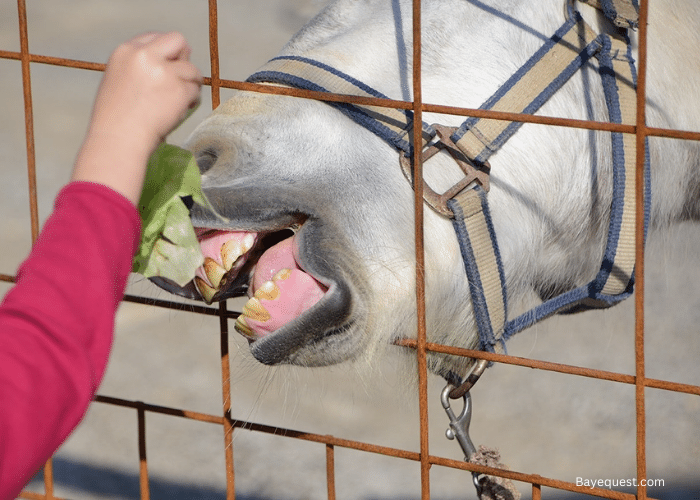Lettuce is a staple in many kitchens. It’s crisp, green, and perfect for a salad. But what about your horse?
Can that crunchy leaf be more than just human food? Horses have unique diets, and it’s important to know what’s safe.
Lettuce might seem harmless, but is it a good choice for your four-legged friend? Let’s dive in and uncover if this leafy green belongs in your horse’s diet or if it’s best left for your dinner plate.
The answer might surprise you.
Can Horses Eat Lettuce? Key Takeaway
Yes, horses can eat lettuce. Lettuce is safe for horses and can be offered as an occasional treat. However, not all horses enjoy its taste or texture, so it’s based on individual preference. Always feed lettuce in moderation, ensuring it’s clean and fresh, as part of a varied diet without replacing essential nutrients.
Should Horses Eat Lettuce?
Yes, horses can eat lettuce, but only occasionally and in small amounts. Lettuce is safe for them, but it lacks essential nutrients and should not replace their primary forage.
Always ensure the lettuce is fresh and free from pesticides, and treat it as a minor supplement, not a regular part of their diet.
How Much Lettuce Can Horses Eat?
When considering how much lettuce to feed a horse, it’s best to view lettuce as a treat rather than a dietary staple.
A few leaves of lettuce—about a small handful—is an appropriate amount. This can be offered two to three times per week.
Lettuce provides minimal nutritional value but can add a bit of variety to a horse’s diet without adding excess calories. Introducing lettuce slowly to monitor how the horse tolerates it is important.
Always ensure that the lettuce is fresh, clean, and pesticide-free.
Types of Lettuce Suitable for Horses
When feeding lettuce to horses, choose types that are safe and healthy. Here are some common types of lettuce that you can safely offer to your horse:
Romaine lettuce. This type of lettuce is nutritious, offering more vitamins and minerals than others. It’s also crunchier and has a higher water content, which can be refreshing for the horse.
Green leaf lettuce. Like romaine, green leaf lettuce is relatively high in nutrients and water content, making it a good option for a light snack.
Red leaf lettuce. In nutritional content, red leaf lettuce is similar to green leaf lettuce. Adding color to your horse’s treat time is another safe option.
Butter lettuce. Also known as Boston or Bibb lettuce, butter lettuce has a softer texture and is low in fiber. It’s suitable for horses but should be given in moderation due to its lower nutritional value than romaine or leaf lettuce.
Types of Lettuce that are Unsafe for Horses
Most common types of lettuce are safe for horses. However, there’s one particular type of lettuce that’s often debated.
That is the Iceberg Lettuce. While not exactly unsafe, iceberg lettuce is generally not recommended for horses.
Iceberg lettuce has very low nutritional value compared to other lettuce varieties, such as romaine or leaf. It consists mostly of water, and its minimal fiber content offers little benefit to a horse’s diet.
Beyond the type of lettuce, the most significant risks associated with feeding lettuce are not typically about the type itself but how it’s prepared and served.
Nutritional Content of Lettuce
Here’s a table outlining the nutritional content of lettuce, specifically focusing on romaine lettuce. The values are approximate and based on a 100-gram serving of raw romaine lettuce:
| Nutrient | Amount |
| Calories | 17 kcal |
| Water | 95.64 g |
| Protein | 1.23 g |
| Carbohydrates | 3.29 g |
| Fiber | 2.1 g |
| Sugar | 1.19 g |
| Calcium | 33 mg |
| Iron | 0.97 mg |
| Magnesium | 14 mg |
| Phosphorus | 30 mg |
| Potassium | 247 mg |
| Sodium | 8 mg |
| Vitamin C | 4.0 mg |
| Vitamin A | 8710 IU (as beta-carotene) |
| Vitamin K | 102.5 µg |
| Folate (Vitamin B9) | 136 µg |
Benefits of Feeding Lettuce to Horses
Feeding lettuce to horses can offer some nice benefits. They include:
Hydration. Lettuce has a high water content, making it an excellent choice for hydration. This is especially beneficial during hot weather or for horses that might not drink enough water.
Low in calories. Lettuce is low in calories, which makes it a suitable treat for horses that are overweight or prone to gaining weight easily. It allows for a treat without a significant calorie addition.
Source of vitamins. Lettuce provides essential vitamins such as vitamins A and K. Vitamin A supports vision, immune function, and skin health, while Vitamin K is crucial for blood clotting and bone health.
Dietary variety. Introducing lettuce can add variety to a horse’s diet. This enhances their eating experience and prevents boredom with their regular feed.
Fiber content. While not as high in fiber as other forages, lettuce still offers some fiber, which can help with digestive health.
Safe treat option. Lettuce is generally safe for horses when introduced properly and fed in moderation. It’s a good alternative to treats with higher sugar or starch.
How to Incorporate Lettuce into a Horse’s Diet
Introducing lettuce into a horse’s diet is a refreshing change. However, you must do it thoughtfully to ensure it is beneficial and not disrupt their overall nutritional balance.
Here’s a step-by-step guide on how to incorporate lettuce into a horse’s diet:
Start with a small amount. Offer your horse a few lettuce leaves to see how they react. Starting with a small quantity is important to ensure your horse has no adverse reactions, such as digestive upset.
Choose the right type of lettuce. Opt for lettuce with higher nutritional value, such as romaine, green leaf, or red leaf. Avoid iceberg lettuce, which has minimal nutritional content and is mostly water.
Wash thoroughly. Always wash the lettuce well to remove potential pesticides, herbicides, or contaminants.
Chop it up. Chop the lettuce into manageable pieces to make it easier for your horse to eat and digest. This reduces the risk of choking and helps integrate it into their regular feed.
Mix with regular feed. Initially, you might want to mix the lettuce with your horse’s feed. This can help them get used to the new food item mixed with familiar tastes.
Monitor your horse’s reaction. After introducing lettuce to their diet, keep an eye on your horse. Look for signs of gastrointestinal discomfort or changes in feeding behavior. If any negative symptoms arise, consult your veterinarian.
Gradually increase the amount. If your horse responds well to lettuce, you can gradually increase the amount given, keeping it as a minor component of the overall diet to maintain nutritional balance.
Regular rotation. Include lettuce as a part of a rotational diet with other safe fruits and vegetables. This variation can enrich the horse’s diet and prevent boredom.
Consult with a veterinarian. Before making any significant changes to your horse’s diet, it’s a good idea to consult with a veterinarian or an equine nutritionist. They can provide guidance based on your horse’s specific health needs and lifestyle.
Precautions to Take When Feeding Horses Lettuce
When feeding lettuce to horses, taking certain precautions is important to ensure it is a safe and healthy treat. Here are some key considerations:
Moderation. Always feed lettuce in moderation. Although it’s safe for horses, it should only be a small part of their diet. Overfeeding can lead to nutritional imbalances or digestive issues, as lettuce is not very nutrient-dense.
Gradual introduction. Introduce lettuce slowly into your horse’s diet. Start with a few leaves and observe how your horse reacts over several days. This approach helps you identify any negative reactions or digestive discomfort.
Thorough washing. Wash all lettuce thoroughly to remove potential pesticides, herbicides, and contaminants. Organic lettuce is a good choice to further minimize exposure to chemicals.
Proper chopping. Chop the lettuce into appropriate sizes to prevent choking hazards and to make it easier for your horse to digest.
Check for allergies and sensitivities. Just like humans, horses can have allergies or sensitivities to certain foods. Monitor your horse for signs of allergic reactions or digestive upset after eating lettuce.
Avoid spoiled lettuce. Never feed wilted, rotten, or moldy lettuce to horses. Spoiled vegetables can harbor bacteria and toxins that are harmful to equine health.
Variety and balance. Ensure that lettuce does not replace essential components of the horse’s diet. It should be offered as a treat alongside a balanced diet rich in fiber and other nutrients.
Consult with a veterinarian. If you are unsure about adding lettuce or any new food to your horse’s diet, consult a veterinarian.
Horses that Should Not Eat Lettuce
While lettuce can be a safe and enjoyable treat for many horses, feeding lettuce might not be appropriate in certain conditions and circumstances. Here are some scenarios where you should avoid giving lettuce to horses:
Horses with digestive issues
If a horse has a history of colic, chronic diarrhea, or other digestive tract disorders, introducing lettuce could exacerbate these issues.
The high water content and low fiber compared to typical forage can disrupt the delicate balance needed in their digestive systems.
Horses with metabolic disorders
Even though lettuce is low in sugar, any changes in diet should be approached cautiously for horses with metabolic conditions like Equine Metabolic Syndrome or insulin resistance.
Also, you need to maintain a controlled diet to manage their condition effectively.
Horses on a strict diet regimen
Horses on specially formulated diets for health issues (e.g., liver or kidney disease) or performance reasons should not be altered without veterinary guidance.
Adding something like lettuce might interfere with the nutritional balance they need.
Horses with allergies
Although rare, if a horse has allergic reactions to certain types of vegetables or has specific food sensitivities, lettuce might need to be avoided to prevent adverse reactions.
Obese horses
Focus on nutrient-dense feeding for overweight horses on a calorie-restricted diet. Lettuce, while low in calories, offers minimal nutritional benefits and might not be suitable for their dietary needs.
Other Vegetable Treats for Horses
Here are some vegetables that are safe and beneficial for horses:
- Carrots
- Celery
- Pumpkin
- Beetroot
- Cucumber
- Peas
- Squash
- Zucchini
- Broccoli (Read more on horses eating broccoli in our next guide.)
FAQs
Can horses eat squash and zucchini?
Yes, horses can eat squash and zucchini. These vegetables are safe for horses and provide good nutrition, including vitamins and fiber. They should be fed in moderation and chopped into appropriate sizes to prevent choking.
Can horses eat celery?
Yes, horses can eat celery. It is a low-calorie treat that offers hydration and is also a good source of vitamins. Celery should be washed thoroughly and cut into manageable pieces to ensure it is safe for horses to consume.
Can Horses Have Lettuce? Conclusion
Can horses eat lettuce? Absolutely, but like any treat, it’s all about balance. Lettuce can be a refreshing snack, especially on warm days, offering hydration and a crunch that horses enjoy.
Remember to wash it well, chop it up, and feed it in moderation. While it’s not packed with nutrients, it’s a safe, low-calorie treat that can add a little variety to your horse’s diet.
Always watch how your horse reacts to new foods, and chat with your vet if you’re unsure. Here’s to happy, healthy snacking for your four-legged friend.








